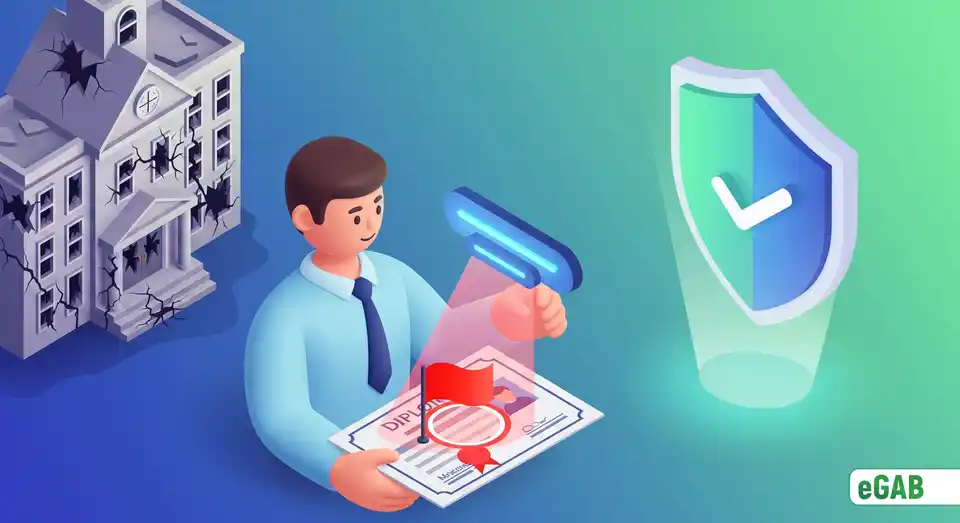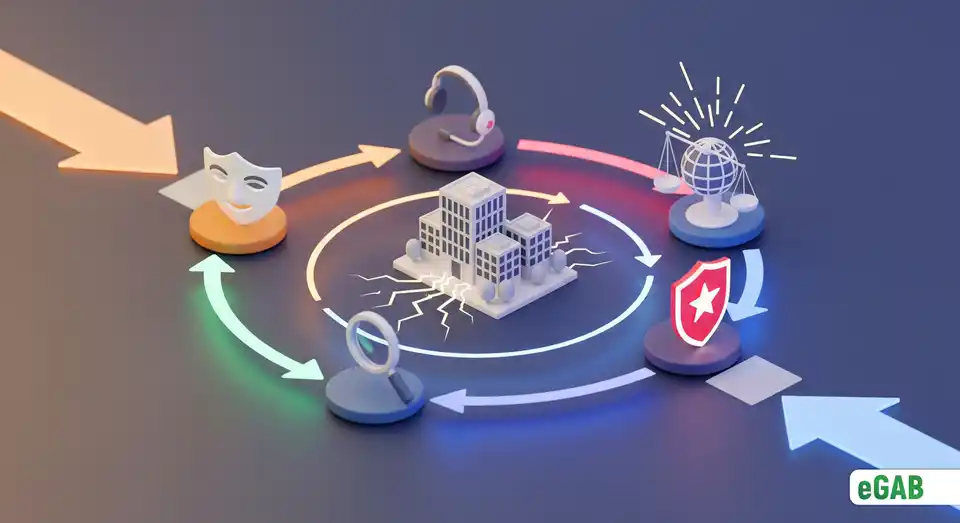The Axact Case: Anatomy of an International "Diploma Mill"

 Author:
Artem Grigoriev
Author:
Artem Grigoriev
What if one of the world's most celebrated IT companies was a total fraud? Imagine a company hailed as a beacon of national pride. But in reality, it was secretly the engine behind one of the most audacious criminal enterprises of our time.
This disturbing scenario wasn't some small-time con; it was the shocking truth behind the Axact diploma mill . This was a global empire that had perfected the art of online education scams. How did they pull it off? By selling completely fake degrees to hundreds of thousands of people. And here's the most tragic part: that group included professionals like doctors and engineers.
The company's charismatic founder, Shoaib Ahmed Shaikh , masterminded the whole operation. He helped Axact build a sophisticated and convincing facade of legitimacy. All the while, the company was running a vast, aggressive network of sham universities and call centers that successfully raked in hundreds of millions of dollars.
In this comprehensive guide, we'll dissect the entire Axact scandal . We'll explore its intricate methods, cover the shocking scale of its worldwide operations, and look at the international investigation that exposed this massive diploma mill fraud to the world.
📘 This post is part of our comprehensive guide to "eGAB:The Global Academic Blockchain Ecosystem for Digital Credentials". Explore it to find answers to all your questions ;)
Origins and Corporate Structure
Have you ever wondered how a global criminal enterprise could operate in broad daylight? Let's uncover the incredible story of Axact. For anyone wondering who is the founder of Axact , his name is Shoaib Ahmed Shaikh, and he was the mastermind behind a very convincing lie. On the surface, Axact presented itself as a runaway success. Founded in 1997 by Shoaib Ahmed Shaikh, it posed as a thriving software company headquartered in Karachi, Pakistan. By 2013, the company boldly claimed it had a workforce of over 5,200 employees and a global customer base of 8.3 million. We now know these staggering numbers were completely fabricated, designed to build a powerful illusion of legitimacy.
Here's the critical point: this booming IT firm was really just an elaborate mask. Behind this sophisticated facade, Axact meticulously ran one of the most complex scams imaginable. They acted as the puppet master, controlling a vast and intricate network. This network included at least 370 websites for fake high schools and colleges. It even had its own bogus accreditation agencies-fake organizations created to pretend to certify a school's quality. They ingeniously designed all of this from the ground up to deceive a global audience hungry for educational credentials, which highlights why a PDF diploma doesn't protect against fraud.
The key takeaway? This was far from a simple back-alley scheme. Axact skillfully built one of the largest and most intricate diploma mills in history. To do this, they used a dizzying maze of call centers and offshore shell companies-businesses registered in other countries specifically to hide financial trails. Armed with hundreds of sham websites, they ultimately defrauded more than 215,000 unsuspecting individuals. These victims were located in 197 different countries. In just five years, from 2010 to 2015, Axact pocketed an estimated $205 million.
Why It Matters: The story of Axact is both a chilling and an important lesson. It vividly shows just how easily an impressive corporate image can be used to hide a massive criminal operation. The case reveals how vulnerable our trust has become in the digital age. What's more, it shows how a well-crafted online presence can successfully devalue genuine academic and professional achievements on a global scale.

Modus Operandi
So, how did Axact actually pull off this unbelievable scam? That’s the key question that unlocks the whole scheme: how did the Axact diploma mill work? Their strategy, or modus operandi , was a masterclass in psychological manipulation, using a clever mix of digital smoke and mirrors and complex financial tricks. The entire operation was designed from the ground up to prey on people's trust. Its ultimate goal was to trap victims in a completely fake, self-contained system-a textbook case of sophisticated online fraud .
-
The Call-Center Engine: Picture this: a massive office where 2,000 sales agents hammered the phones, making up to 5,000 calls every single day. But these weren't your average sales calls. The agents were trained to hide their accents and impersonate officials from the U.S., U.K., and the Middle East. This was call center fraud on a scale that’s hard to imagine. They used aggressive, high-pressure sales tactics and even made up fake government rules to bully customers into paying for bogus "legalization fees" and other worthless extras.
-
A Universe of Fake Institutions: Axact didn't just create one fake school; it built an entire fraudulent ecosystem-a complex web of fake organizations. They launched slick, professional-looking websites for completely fictional universities with plausible names like " Belford University ." To make the lie believable, they even set up their own fake accreditation boards. Now, here’s the most brilliant part of the scam. Whenever an employer tried to check a diploma, Axact cleverly routed the request back to another one of their own employees, who would then confidently confirm it was legitimate. This perfectly demonstrates the hidden costs of verification in traditional systems.
-
Degrees for "Life Experience": At its heart, the product they sold was simple: a degree that required zero studying. Customers could buy official-looking credentials based on nothing more than their " life experience ." They might pay a few hundred dollars for a basic diploma or, in some cases, hundreds of thousands for a more advanced degree. In return, they got a stunningly realistic document, complete with official-looking watermarks and seals.
-
Laundering the Profits: How do you launder nearly $90 million in dirty money in a single year? Axact’s financial scams were just as clever as its deceptions. The company funneled its massive profits through a complex web of shell companies. They registered these shadowy businesses in different places with different laws, like the U.S., the Caribbean, and the UAE. From there, they wired the money back to Pakistan, brilliantly disguising it as legitimate income from software sales. This strategy let them operate completely under the radar for years.
Quick Insight: The true genius of Axact's operation was creating a perfect closed-loop system. You can think of it like an elaborate movie set: everything looks real, but it's all part of the same production. They controlled the "universities," the "accreditation boards," and, most importantly, the "verification" process. This brilliant structure built a fortress of fraud that was nearly impossible for any outsider to break.

Scale and Reach
It's hard to fully grasp the enormous scale of the Axact operation. This wasn't some small-time local scam; it was a global criminal empire that turned deception into an industrial-scale business, making it a truly international scam . The numbers below, pieced together from various investigative reports, give you a clear sense of just how widespread this diploma mill really was. And they directly answer the pressing question: how much money did Axact make from fake degrees?
|Metric|Value|Source| |---|---|---| |Fake‐degree recipients (2010–2015)|~240,000| 6 | |Customer countries|197| 3 | |Websites for fake universities & schools|>370| 1 | |Annual revenue from fake credentials (2015)|$51 million (350 fictitious institutions)| 7 | |Cumulative earnings (2010–2015)|>$205 million| 6 |

Investigations and Legal Proceedings
Every empire, no matter how powerful, eventually has its day of reckoning. For Axact, that day finally came in 2015. So, what was the Axact scandal exactly, and how was the Axact scam exposed? The events of that year set off a chain of international investigations and legal battles that finally blew the lid off its massive fraud.
-
May 2015 – The New York Times Exposé: The first domino fell with a bombshell investigation-an exposé (a public report on a shocking situation)-published by Declan Walsh for The New York Times, titled "Fake Diplomas, Real Cash." This incredibly detailed report uncovered Axact’s sprawling web of over 370 fake university sites and its huge army of agents selling bogus degrees. The findings in this New York Times Axact exposé triggered an immediate and widespread Axact investigation . The story went viral overnight, forcing Pakistan’s Federal Investigation Agency (FIA) to raid Axact's offices. Inside, they hit a goldmine of evidence, including huge stacks of blank degrees from their fake universities and highly detailed customer records.
-
2015–2016 – The Pakistani Prosecution: The fallout from the exposé was fast and furious. CEO Shoaib Shaikh and 22 of his top associates were arrested almost immediately. In the prosecution that followed (the legal process for charging someone with a crime), they faced a barrage of serious charges, including fraud, money laundering, and illegal document trafficking. The Axact money laundering charge was especially critical due to the complex web of shell companies they used. The case quickly became a textbook example of massive corporate crime . But then the case took a bizarre turn when they were initially acquitted (found not guilty), only for the verdict to be overturned after it was discovered the judge had been bribed. In a twist worthy of a crime thriller, Shaikh was arrested again in March 2023 for bribery, though higher courts later acquitted him. For those still asking, "What happened to Shoaib Shaikh?" , his legal battles have been a complete rollercoaster, but so far he's managed to avoid a final conviction on the core charges in Pakistan.
-
United States Actions: The long arm of the law also reached out from the U.S. In August 2017, a federal court sentenced Umair Hamid, Axact’s Assistant VP of International Relations and a key figure in the scheme, to 21 months in prison. The U.S. Department of Justice announcement made it perfectly clear that he played a central role in defrauding American consumers by tricking them into paying fake "accreditation fees."
-
International Exposés: The scandal sent shockwaves across the globe, prompting other countries to uncover the true scale of the damage: - BBC (UK) 2018: A report found that over 3,000 UK citizens, including NHS healthcare professionals and consultants, had bought fake degrees from Axact. - CBC (Canada) 2017: Canadian investigators discovered that over 800 professionals in Canada, including engineers and nurses, had diplomas from Axact schools. To show just how easy it was, they bought PhDs for less than $1,600. The "exam"? Just a short, unverified phone call. - Interpol & British Home Office: Global law enforcement agencies worked closely with diploma mill expert and former FBI agent Allen Ezell . They confirmed the operation's staggering scale, estimating that Axact had targeted millions of potential customers with its slick marketing.
Did You Know? The investigation i
nto Axact quickly became a massive global effort for a very serious reason. This wasn't just about money; it was about public safety. People with these fake credentials had managed to land jobs in critical fields like healthcare, defense, and engineering in dozens of countries. This created a real and measurable risk to all of us, underscoring why blockchain and NFTs are essential for credential verification.

Organizational Network
To truly understand how Axact pulled this off, you need to picture the vast, intricate web they spun. At its heart was a massive network of Axact fake universities , a world away from legitimate systems like the Global Academic Blockchain Ecosystem (eGAB) for digital credentials. This wasn't just a few fake websites; it was a sprawling digital empire meticulously built to deceive on an industrial scale. They expertly used tools like search engine optimization and online ads to lure unsuspecting victims. So, what were some of Axact's fake university names? The network included:
-
145 fictitious universities with highly professional websites, such as Brooksville University and Kingsbridge University.
-
41 fake high schools designed to create a complete, fraudulent educational history, with plausible names like Bay View High School.
-
18 sham accreditation boards , like the "International Accreditation Organization," created solely to give their fake schools a bogus stamp of approval.
-
121 dedicated degree portals where customers could enroll and, more importantly, where employers could "verify" the fake credentials, trapping them in Axact's closed loop and completing the scam.
Takeaway: Axact's immense success was built on a simple yet incredibly powerful idea: create so much digital complexity that it was impossible for any one person to see the whole picture. By building hundreds of interconnected and seemingly legitimate websites, they made it nearly impossible for any individual or regulator to spot the overarching fraud. Each piece of this elaborate puzzle was masterfully designed to make all the others look completely real.

Aftermath and Ongoing Impact
When the Axact scandal broke, it sent shockwaves through the worlds of education and employment. This wasn't just an issue of academic integrity; it exposed a major public safety risk from unqualified people landing critical jobs. But the story didn't end with the arrests. The scandal left a permanent scar, forcing everyone to completely rethink credential verification (the process of confirming a qualification is real). It’s a harsh reminder that online academic fraud is always evolving, which makes the case for the future of digital academic credentials on the eGAB Global Academic Blockchain stronger than ever.
-
Global Crackdowns: Right after the scandal hit, countries worldwide scrambled to tighten their verification processes using better digital and manual checks. This makes a lot of people ask: is Axact still in operation? While its original structure was mostly taken down, reports suggest that parts of its huge network are still running under new names. But the fight is far from over. Diploma mills are still out there, often popping up on new websites and using even slicker marketing tricks to stay hidden.
-
Crucial Awareness Tools: Experts like former FBI agent Allen Ezell created valuable "red-flag" lists to help people spot fakes. Organizations like the Council for Higher Education Accreditation (CHEA) now actively promote these vital resources to warn against diploma mills . They give employers the essential tools they need to spot the tell-tale signs of fraud. If you're asking, "what are the signs of a diploma mill?" , these resources are priceless. So, how can you verify a university's accreditation? Key things to watch out for include no physical campus, pressure to pay for a degree upfront, and accreditation from organizations nobody has ever heard of.
-
Disturbing Data Leaks: Even today, chilling new details about the operation are still coming out. Beyond the scam itself, the mountain of customer data Axact collected is a ticking time bomb for a potential data breach -exactly the kind of risk that's prevented by the secure framework of blockchain, NFTs, TTP, and CA for academic credentials. A 2024 interview on the Darknet Diaries podcast with a former insider revealed just how deep the rabbit hole went. He explained how Axact could clone and launch a brand-new university website in just minutes. They also profiled their customers to hit them with expensive upsells (getting them to buy more) and used all sorts of psychological tricks to keep them paying for worthless "certifications."
Conclusion: The Axact case is more than a story about a massive scam; it's a blueprint for how modern, large-scale digital fraud works. The Axact scandal is now practically the definition of a fake degree scam . It shows exactly how a determined criminal group can use corporate structures, slick digital platforms, and complex global finance to attack one of society's most fundamental pillars: our trust in education. This massive case of diploma mill fraud is a powerful warning about the growing threat of online education scams . Axact's ultimate legacy is a world that's now more skeptical, but also much more aware. We now have new tools and a painful, hard-won understanding of the vulnerabilities in our global systems.
Next Step: If you're an employer or work in HR, the lesson here is absolutely critical. You must
learn the red flags of diploma mills. Always verify credentials through a recognized, independent body. In the U.S., that's CHEA; find the one in your country. Remember to check for basics like a physical campus address, be suspicious of any pressure tactics to enroll quickly, and always question accreditation from unfamiliar organizations. A few minutes of due diligence (taking reasonable steps to satisfy a legal requirement) can save you from a costly mistake and prevent an embarrassing-and potentially dangerous-hire.

Summary: Deconstructing a Blueprint for Global Deception
So, when you put all the pieces together, what's the real story of Axact? In short, it’s a chilling and instructive blueprint for modern, large-scale digital crime. This wasn't just a simple fake degree scam . On the contrary, it was a meticulously engineered corporate empire built on a foundation of pure deception.
The whole operation started with a very convincing facade, presenting Axact as a booming Pakistani software giant under its founder, Shoaib Ahmed Shaikh . Behind this mask, however, a sophisticated engine of fraud was at work. The company’s modus operandi (its method of operation) was a masterclass in manipulation. It involved using aggressive call center fraud to bully customers and funneling hundreds of millions in illegal profits through a complex web of shell companies to run its Axact money laundering scheme.
The true genius of the operation, however, was its vast and self-contained fraudulent ecosystem. Think about it: they created a sprawling network of over 370 Axact fake universities and even established their own bogus accreditation boards. With this, Axact successfully built a closed-loop system where its deceptions were nearly impossible to expose from the outside.
The sheer scale and reach of this international scam were breathtaking. It ultimately hit over 215,000 victims across 197 countries, raising serious questions about just how vulnerable our global systems really are. In 2015, the entire house of cards began to collapse after the explosive New York Times Axact exposé . That story triggered a massive wave of international investigations and legal proceedings in both Pakistan and the United States.
Ultimately, the aftermath of the Axact scandal serves as its most critical lesson. It exposed a profound public safety risk . Why? Because thousands of individuals were found holding fake credentials in critical fields like healthcare and engineering. While global crackdowns later dismantled the original network, the case forced a much-needed reckoning in credential verification . It gave organizations like the Council for Higher Education Accreditation (CHEA) the ammunition they needed to finally raise public awareness. As a result, we've all become more vigilant against online education scams , and understanding the tangible benefits of eGAB for universities, students, and employers can help prevent future incidents.
Axact's legacy is a world that is now far more skeptical-but because of that, it's also a world that's far better prepared. It serves as a permanent warning against the ever-evolving threat of diploma mill fraud .
➡️ So, what's the solution? Understanding the severity of fraud shows why you need a robust technological foundation. The next step is choosing the right blockchain, with our 2025 comparison guide.

Why Leading Universities Choose eGAB for Issuing & Managing Digital Credentials
The Tangible Benefits of eGAB for Universities, Students, and Employers
How eGAB Fulfills the Vision of the Global Digital Credentials Management Program
Blockchain, NFT, TTP & CA for Academic Credentials: A Simplest Explanation
Why Blockchain and NFTs Are Essential for Credential Verification
